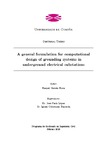Mostrar o rexistro simple do ítem
A general formulation for computational design of grounding systems in underground electrical substations
| dc.contributor.advisor | París, José | |
| dc.contributor.advisor | Colominas Ezponda, Ignasi | |
| dc.contributor.author | Guizán Roca, Raquel | |
| dc.date.accessioned | 2018-05-07T17:57:31Z | |
| dc.date.available | 2018-05-07T17:57:31Z | |
| dc.date.issued | 2018 | |
| dc.identifier.uri | http://hdl.handle.net/2183/20691 | |
| dc.description | Programa Oficial de Doutoramento en Enxeñaría Civil . 5011V01 | es_ES |
| dc.description.abstract | [Abstract] Electricity has become an essential element in our lives, which is necessary in our daily routine to do basic tasks as work or communicate. This makes the correct supply of electricity a fundamental issue. One of the elements in charge of the electricity supply is the electrical substations. As a consequence of the considerable population growth in cities and the increasing demand for power and power supply have caused the construction of new electrical substations in urban areas. However, this construction has become in a challenge because of factors as the limited availability of space or the cost of urban land. Consequently, engineers developed the underground electrical substations, which consist of compact solutions buried in the ground. A key element to keep in mind in electrical substations is safety, especially during a fault condition. Grounding systems are the devices in charge of guaranteeing the proper functioning of electrical substations and the safety conditions for people in these situations. The correct design and analysis of grounding grids have become an essential procedure in the underground electrical substations, since they are located in urban areas. A grounding grid is mainly characterised by the ground resistance, the ground potential rise, and the step, touch and mesh voltages. In this thesis a general formulation to design and analyse properly grounding systems of underground electrical substations has been developed, which allows to represent a realistic soil structure in order to calculate with a good accuracy their main parameters. The function of a grounding system is to carry and dissipate the fault electric current into the ground, causing the appearance of potential gradients within and around substations. To achieve the formulation, the physical phenomenon of a fault current derivation into the ground through a grounding system was study by means of the Maxwell's Equations. Thus, a mathematical approach based on the steady-state behaviour of the general equations of electromagnetism has been carried out in order to model this derivation of electric current. The procedure to obtain this mathematical model was to study each conductive domain that formed the soil structure, a uniform soil and a non-homogeneous finite volume, as if they were separated from each other, and then coupled for their resolution. After that, two systems of equations defined by potential functions are obtained, which are related between them by the compatibility conditions applied on the surface of the enclosure. To achieve a problem which can be solved by numerical techniques, the mathematical approach was recast into three boundary integral equations by means of the concepts of potential theory. The numerical technique chosen to solve these boundary integral equations is the Boundary Element Method (BEM), since it is the appropriate method to solve the governing equations proposed to model the electric current derivation to an infinity domain like the ground. Before applying this technique, the strong form of the boundary integral equations are reformulated in their weak form from which accurate approximate solutions can be calculated by means of the weighted residual methods. Thus, two numerical approaches are carried out to solve the boundary integral equations, one based on the Point Collocation and other on the Bubnov-Galerkin Method. The results obtained from the resolution of both numerical approaches allows to calculate the values of the leakage current densities emanating from the surface of the grounding grid to the ground, as well as the current densities and electric potential distributions on the substation enclosure. Therefore, the electrical potential at any point in the ground can be calculated, and so the earth surface potential distribution. Then, from this surface distribution, the main parameters that characterised a grounding system can be calculated. Finally, the general formulation developed is applied to analyse grounding systems for real underground electrical substations. The model shows excellent results for these analyses and proves that the formulation allows to calculate the main parameters of these facilities with good accuracy. | es_ES |
| dc.language.iso | eng | es_ES |
| dc.rights | Os titulares dos dereitos de propiedade intelectual autorizan a visualización do contido desta tese a través de Internet, así como a súa reproducción, gravación en soporte informático ou impresión para o seu uso privado e/ou con fins de estudo e de investigación. En nengún caso se permite o uso lucrativo deste documento. Estos dereitos afectan tanto ó resumo da tese como o seu contido Los titulares de los derechos de propiedad intelectual autorizan la visualización del contenido de esta tesis a través de Internet, así como su repoducción, grabación en soporte informático o impresión para su uso privado o con fines de investigación. En ningún caso se permite el uso lucrativo de este documento. Estos derechos afectan tanto al resumen de la tesis como a su contenido | es_ES |
| dc.subject | Subestaciones eléctricas-Diseño y construcción | es_ES |
| dc.subject | Corrientes eléctricas-Puesta a tierra | es_ES |
| dc.title | A general formulation for computational design of grounding systems in underground electrical substations | es_ES |
| dc.type | info:eu-repo/semantics/doctoralThesis | es_ES |
| dc.rights.access | info:eu-repo/semantics/openAccess | es_ES |
Ficheiros no ítem
Este ítem aparece na(s) seguinte(s) colección(s)
-
Teses de doutoramento [2150]






